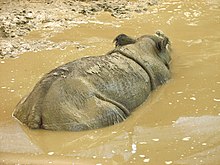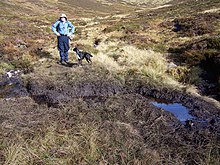
The common warthog is a wild member of the pig family (Suidae) found in grassland, savanna, and woodland in sub-Saharan Africa. In the past, it was commonly treated as a subspecies of P. aethiopicus, but today that scientific name is restricted to the desert warthog of northern Kenya, Somalia, and eastern Ethiopia.

The Javan rhinoceros, Javan rhino, Sunda rhinoceros or lesser one-horned rhinoceros is a critically endangered member of the genus Rhinoceros, of the rhinoceros family, Rhinocerotidae, and one of the five remaining extant rhinoceros species across South Asia and Africa. The Javan rhinoceros is one of the smallest rhinoceros species, along with the Sumatran, or “hairy”, rhinoceros. They are superficially similar to Indian one-horned rhinos, as they posses plate-like, “armored” protective skin folds, but are slightly smaller in size, at just 3.1–3.2 m (10–10 ft) long and 1.4–1.7 m (4.6–5.6 ft) tall, on average. The heaviest specimens weigh around 2,300 kg/2.3 tonnes, similar to an African black rhinoceros. However, unlike the long and potentially lethal horns of the black or white rhinoceroses of Africa, the Javan species’ single, somewhat blunted horn is usually shorter than 25 cm (9.8 in).

The Toronto Zoo is a zoo located in Toronto, Ontario, Canada. Encompassing 287 hectares, the Toronto Zoo is the largest zoo in Canada. It is divided into seven zoogeographic regions: Indo-Malaya, Africa, Americas, Tundra Trek, Australasia, Eurasia, and the Canadian Domain. Some animals are displayed indoors in pavilions and outdoors in what would be their naturalistic environments, with viewing at many levels. It also has areas such as the Kids Zoo, Waterside Theatre, and Splash Island. It has one of the most taxonomically diverse collection of animals on display of any zoo worldwide; it is currently home to over 5,000 animals representing over 500 species. The zoo is open to the public every day of the year except December 25.
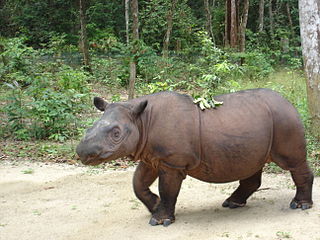
The Sumatran rhinoceros, also known as the Sumatran rhino, hairy rhinoceros or Asian two-horned rhinoceros, is a rare member of the family Rhinocerotidae and one of five extant species of rhinoceros; it is the only extant species of the genus Dicerorhinus. It is the smallest rhinoceros, although it is still a large mammal; it stands 112–145 cm (44–57 in) high at the shoulder, with a head-and-body length of 2.36–3.18 m and a tail of 35–70 cm (14–28 in). The weight is reported to range from 500–1,000 kg (1,100–2,200 lb), averaging 700–800 kg (1,500–1,800 lb). Like both African species, it has two horns; the larger is the nasal horn, typically 15–25 cm (5.9–9.8 in), while the other horn is typically a stub. A coat of reddish-brown hair covers most of the Sumatran rhino's body.

The rut is the mating season of certain mammals, which includes ruminants such as deer, sheep, camels, goats, pronghorns, bison, giraffes and antelopes, and extends to others such as skunks and elephants. The rut is characterized in males by an increase in testosterone, exaggerated sexual dimorphisms, increased aggression, and increased interest in females. The males of the species may mark themselves with mud, undergo physiological changes or perform characteristic displays in order to make themselves more visually appealing to the females. Males also use olfaction to entice females to mate using secretions from glands and soaking in their own urine.

A rhinoceros, commonly abbreviated to rhino, is a member of any of the five extant species of odd-toed ungulates in the family Rhinocerotidae; it can also refer to a member of any of the extinct species of the superfamily Rhinocerotoidea. Two of the extant species are native to Africa, and three to South and Southeast Asia.

The Indian rhinoceros, or Indian rhino for short, also known as the greater one-horned rhinoceros or great Indian rhinoceros, is a rhinoceros species native to the Indian subcontinent. It is listed as Vulnerable on the IUCN Red List, as populations are fragmented and restricted to less than 20,000 km2 (7,700 sq mi). Moreover, the extent and quality of the rhino's most important habitat, the alluvial Terai-Duar savanna and grasslands and riverine forest, is considered to be in decline due to human and livestock encroachment. As of August 2018, the global population was estimated to comprise 3,588 individuals, including 2,939 individuals in India and 649 in Nepal. Kaziranga National Park alone had an estimated population of 2,048 rhinos in 2009. Pobitora Wildlife Sanctuary in Assam has the highest density of Indian rhinos in the world with 84 individuals in an area of 38.80 km2 (14.98 sq mi) in 2009.

The Tabin Wildlife Reserve is a nature preserve in Sabah, Malaysia. It was created in 1984 to preserve Sabah's disappearing wild animals. Occupying a large part of the peninsula forming the northern headland of Darvel Bay, it is located 48 kilometres east of Lahad Datu.
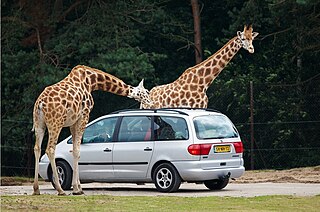
A safari park, sometimes known as a wildlife park, is a zoo-like commercial drive-in tourist attraction where visitors can drive their own vehicles or ride in vehicles provided by the facility to observe freely roaming animals.
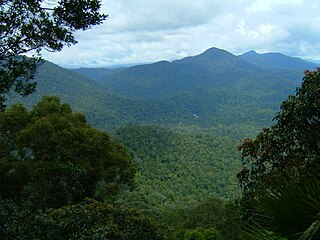
Endau-Rompin National Park is a protected tropical rainforest situated within a massif in the southern foothills of the Tenasserim Hills, straddling Segamat and Mersing Districts in northeastern Johor and Rompin District in southern Pahang. It covers a total land area of approximately 870 km2 (340 sq mi), making it the second-largest national park in Peninsular Malaysia after Taman Negara. It has approximately 26 km (16 mi) of trail. It is the second national park proclaimed by the government of Malaysia. Gunung Besar, the second-highest peak in Johor, is in the park.

The San Antonio Zoo is an Association of Zoos and Aquariums-accredited zoo in Midtown San Antonio, Texas, United States. It is located in the city's Brackenridge Park. San Antonio Zoo is a 50+ acre zoo home to over 750 species, some of which are endangered or extinct in the wild, and an annual attendance of more than 1 million. It also runs non-animal attractions, such as the 2 ft narrow gauge San Antonio Zoo Eagle train ride, which first opened in 1956.
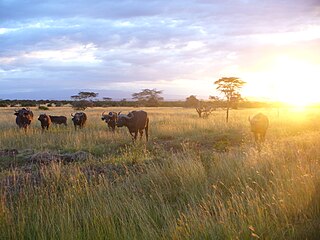
The wildlife of Kenya refers to its fauna. The diversity of Kenya's wildlife has garnered international fame, especially for its populations of large mammals. Mammal species include lion, cheetah hippopotamus, African buffalo, wildebeest (Connochaetes), African bush elephant, zebra (Equus), giraffe (Giraffa), and rhinoceros. Kenya has a very diverse population of birds, including flamingo and common ostrich.
Sarcocystis is a genus of parasitic Apicomplexan alveolates. Species in this genus infect reptiles, birds and mammals. The name is derived from Greek: sarkos = flesh and kystis = bladder.
The Mammalia in the 10th edition of Systema Naturae forms one of six classes of animals in Carl Linnaeus's tenth reformed edition written in Latin. The following explanations are based on William Turton's translations who rearranged and corrected earlier editions published by Johann Friedrich Gmelin, Johan Christian Fabricius and Carl Ludwig Willdenow:
Animals that suckle their young by means of lactiferous teats. In external and internal structure they resemble man: most of them are quadrupeds; and with man, their natural enemy, inhabit the surface of the Earth. The largest, though fewest in number, inhabit the ocean.

The existence of rhinoceroses in ancient China is attested both by archaeological evidence and by references in ancient Chinese literature. Depictions of rhinoceroses in ancient Chinese art are typically very accurate and lifelike, suggesting that they were modelled first-hand by the artist on living rhinoceroses rather than being based on legend or traveller's tales. The main species of rhinoceros that lived in China in ancient times has been identified as the Sumatran Rhinoceros, more especially the Northern Sumatran rhinoceros, although the Indian Rhinoceros and Javan Rhinoceros were also present.

Comfort behaviours in animals are activities that help maintain the pelage, feathers, integuement or musculoskeletal system and increase the physical comfort of the animal.

Self-anointing in animals, sometimes called anointing or anting, is a behaviour whereby a non-human animal smears odoriferous substances over themselves. These substances are often the secretions, parts, or entire bodies of other animals or plants. The animal may chew these substances and then spread the resulting saliva mixture over their body, or they may apply the source of the odour directly with an appendage, tool or by rubbing their body on the source.
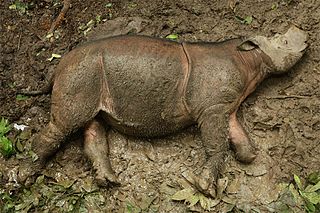
The Bornean rhinoceros, also known as the eastern Sumatran rhinoceros or eastern hairy rhinoceros, is one of three subspecies of Sumatran rhinoceros. The subspecies may be functionally extinct, with only one individual, a female named Pahu, surviving in captivity, and held in the state of Sabah. In April 2015, the Malaysian government declared the Bornean rhinoceros to be extinct in the wild in the Malaysian portion of Borneo. However, in March 2016, a young female rhino was captured in East Kalimantan, providing evidence of their continued existence. The International Union for Conservation of Nature (IUCN) classifies the subspecies as critically endangered.



